
William Floyd was an American Founding Father, wealthy farmer, and political leader from New York. Floyd served as a delegate to the Continental Congress and was a signer of the Continental Association and Declaration of Independence. In August 1776, a few weeks after the Declaration was signed, the British Army overran Long Island, confiscated Floyd's house and estate, and used the property as a base for its cavalry over the next seven years. Floyd remained active in politics throughout the Revolutionary Era, served as a major general in the New York State militia, and was elected to the first U.S. Congress in 1789.
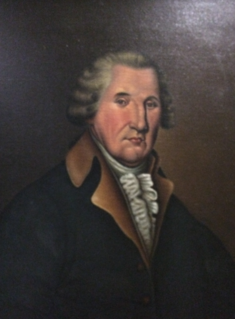
William Hooper was an American Founding Father, lawyer, and politician. As a member of the Continental Congress representing North Carolina, Hooper signed the Continental Association and the Declaration of Independence.
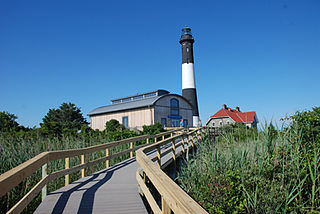
Fire Island National Seashore (FINS) is a United States National Seashore that protects a 26-mile (42 km) section of Fire Island, an approximately 30-mile (48 km) long and 0.5-mile (0.80 km) wide barrier island separated from Long Island by the Great South Bay. The island is part of New York State's Suffolk County and the Outer Barrier.

John Smith was an American politician who served as a United States senator from New York from 1804 to 1813. He previously was the U.S. representative for New York's 1st congressional district from 1800 to 1804. He was a member of the Democratic-Republican Party.
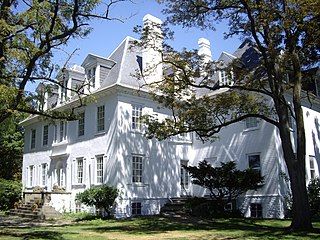
The Clermont State Historic Site, also known as the Clermont estate, the Clermont Manor or just Clermont, is a New York State Historic Site in southwestern Columbia County, New York, United States. It protects the former estate of the Livingston family, seven generations of whom lived on the site over more than two centuries.

The William Floyd School District is located in the southern area of the Town of Brookhaven on Long Island in New York. The district serves the contiguous communities of Shirley, Mastic, Mastic Beach and Moriches. The William Floyd School District is one of the larger school districts on Long Island and is named after William Floyd, one of only 56 men to sign the Declaration of Independence. The district is located on the south shore of Long Island, approximately 60 miles east of New York City, with an enrollment of 8,653 students as of 2016. William Floyd students attend five elementary schools, two middle schools, and a senior high school.

The Thomas Stone National Historic Site, also known as Haberdeventure or the Thomas Stone House, is a United States National Historic Site located about 25 miles (40 km) south of Washington D.C. in Charles County, Maryland. The site was established to protect the home and property of Founding Father Thomas Stone, one of the 56 signers of the United States Declaration of Independence. His home and estate were owned by the Stone family until 1936.
Westernville, New York is a hamlet in Oneida County, located west of Adirondack Park and north of Rome, and Utica. Westernville is in the Town of Western, adjacent to Delta Reservoir and Delta Lake State Park.

Manor St. George or St. George's Manor was a large tract of land purchased by William "Tangier" Smith in the 17th century on Long Island, in central Suffolk County, New York. Parts of the original parcel, which was approximately 64,000 acres (260 km2) of land, are preserved in bits and pieces: 127 acres (0.51 km2) and the main house and buildings are called the Manor of St. George and located in Shirley; 35 acres (0.14 km2) and another house are called the Longwood Estate and located in Ridge; and 35 acres (0.14 km2) became part of the William Floyd Estate.

Caumsett State Historic Park Preserve is a state park on Lloyd Neck, a peninsula extending into the Long Island Sound, in the Village of Lloyd Harbor, New York. It is operated by the New York State Office of Parks, Recreation and Historic Preservation.

The Crailo State Historic Site is a historic, fortified brick manor house in Rensselaer, New York which was built in 1707. The word Crailo is derived from kraaien bos and refers to Kiliaen van Rensselaer's estate in Huizen, Holland, which is also named "Crailo". Fort Crailo is listed on the National Register of Historic Places.
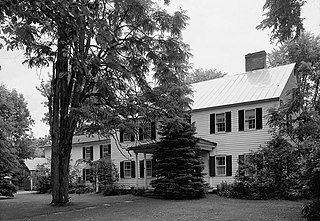
The Gen. William Floyd House is a historic house on Main Street at Gifford Hill Road in Westernville, New York. Built in 1803, it was the last home of Founding Father William Floyd (1734–1821), a signer of the Declaration of Independence, and a driving force in the settlement of the area. It was declared a National Historic Landmark in 1971. The house is a private residence, and is not normally open to the public.
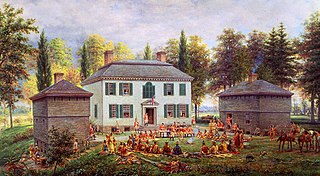
Johnson Hall State Historic Site was the home of Sir William Johnson (1715–1774) an Irish pioneer who became the influential British Superintendent of Indian Affairs in the Province of New York, known for his strong relationship especially with the Mohawk and other Iroquois League nations.

Stonum, also called Stoneham, is a historic house at 900 Washington Avenue in New Castle, Delaware. Its main section built about 1750, it was the country home of George Read (1733-1798), a signer of the Declaration of Independence. His advocacy enabled Delaware to become the first state ratifying the declaration. The house was declared a National Historic Landmark in 1973. It is the only building standing associated with this Founding Father.

Summerseat, also known as the George Clymer House and Thomas Barclay House, is a historic house museum at Hillcrest and Legion Avenues in Morrisville, Bucks County, Pennsylvania. Built about 1770, it is the only house known to have been owned by two signers of the United States Declaration of Independence, Founding Fathers George Clymer and Robert Morris, and as a headquarters of General George Washington during the American Revolutionary War. The house is now managed by the Morrisville Historical Society, which offers tours. It was designated a National Historic Landmark in 1965.

The Nash-Hooper House, also known as the William Hooper House, is a historic house at 118 West Tryon Street in Hillsborough, North Carolina. Built in 1772 by American Revolutionary War general Francis Nash, it was home from 1782–1790 to Founding Father William Hooper, a signer of the United States Declaration of Independence. It is the only known home of Hooper's to survive, and was declared a National Historic Landmark in 1971. It is located in the Hillsborough Historic District; it is a private residence, and is not normally open to the public.
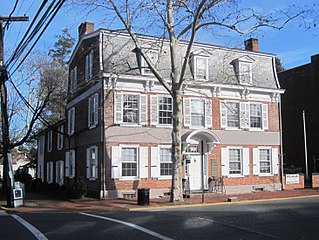
The Francis Hopkinson House is an historic house at 101 Farnsworth Street in Bordentown, Burlington County, New Jersey, United States. Built in 1750, it was the home of Francis Hopkinson (1737-1791), the designer of the United States Flag and a signer of the United States Declaration of Independence. He lived in this home with his wife Ann Borden (1747-1827) from 1774 until Hopkinson's death in 1791. Ann Borden was the granddaughter of Joseph Borden, the founder of Bordentown, New Jersey. The house was designated a National Historic Landmark in 1971.

Meadow Garden is a historic house museum at 1320 Independence Drive in Augusta, Georgia. It was a home of Founding Father George Walton (1749–1804), one of Georgia's three signers of the U.S. Declaration of Independence, and later a governor of Georgia and a United States senator. Meadow Garden was saved and established as a museum by the Daughters of the American Revolution in 1901. It was declared a National Historic Landmark in 1981.

Van Schaick House is a historic home located on Van Schaick Island at Cohoes in Albany County, New York. It was built about 1735 and is a 1+1⁄2-story, brick dwelling with a gambrel roof. Plans were made at the mansion for the Battle of Saratoga and the house was used by Governor Clinton as the New York State Capitol from August 22 to 25, 1777.
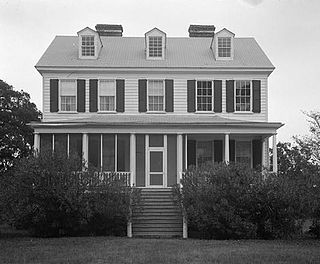
Cassina Point was built in 1847 for Carolina Lafayette Seabrook and her husband, James Hopkinson. Carolina Seabrook was the daughter of wealthy Edisto Island planter William Seabrook. William Seabrook had hosted the General Lafayette in 1825 at his nearby home at the time of Carolina's birth. Seabrook gave Lafayette the honor of naming the newborn child, and the general selected Carolina and Lafayette. When Carolina Seabrook married James Hopkinson, they built Cassina Point on the land given to them by William Seabrook.























